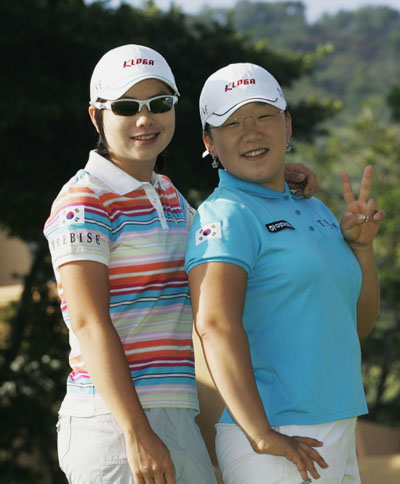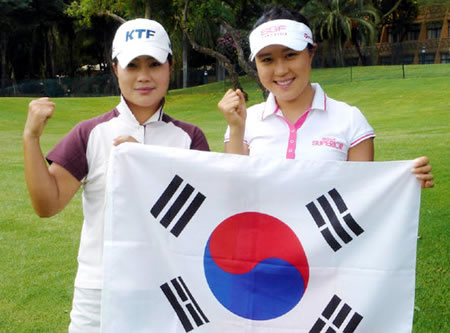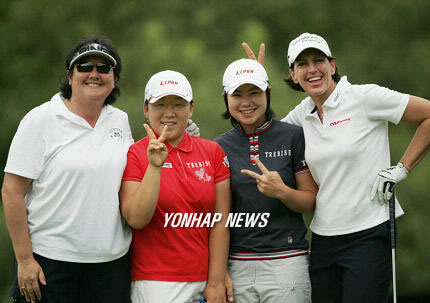 |
 |
 |
 |
 |
 |
2008 Women's World Cup
 The
Solheim Cup is one of the older team events in women's professional golf,
having been created in 1990. At the time it was created, the majority
of top players in the world came from either the US or Europe, and so
the teams that were created were formed of golfers from those two regions.
But since the mid-90s, and especially in the last few years, there has
been an explosion of great golfers from many other areas of the world:
Asia, of course (particularly Korea), but also Australia, Mexico, South
America, and Canada. None of the golfers from those countries were allowed
to play in the Solheim, though, introducing an opportunity for another
event to be created that would fill that gap. The Women's World Cup and
the Lexus Cup (discussed elsewhere in this issue) are two of these events.
The
Solheim Cup is one of the older team events in women's professional golf,
having been created in 1990. At the time it was created, the majority
of top players in the world came from either the US or Europe, and so
the teams that were created were formed of golfers from those two regions.
But since the mid-90s, and especially in the last few years, there has
been an explosion of great golfers from many other areas of the world:
Asia, of course (particularly Korea), but also Australia, Mexico, South
America, and Canada. None of the golfers from those countries were allowed
to play in the Solheim, though, introducing an opportunity for another
event to be created that would fill that gap. The Women's World Cup and
the Lexus Cup (discussed elsewhere in this issue) are two of these events.
The World Cup started in 2005. Countries which had top players on the money list on the LPGA and Ladies European Tour (and, later, on the Rolex World Rankings) would be allowed to send two player teams to represent them at the Cup. The sponsors would also be allowed to invite some countries not otherwise qualified to give the event more variety. Naturally, South Korea, with umpteen top players, was immediately one of the favorites to take the cup. But the Korean golf world was going through a bit of a change during this time; they went from being largely dominated by a few top players to having literally dozens of world class golfers winning international events. The people in charge of choosing the Korean team decided the only fair thing to do would be to send one Korean golfer who plays primarily on the LPGA and one who plays on the KLPGA to represent the country. This was a bit of a weird decision, in that they could almost certainly have created stronger teams by sending two top LPGA golfers (like, say, Grace Park and Se Ri Pak). But perhaps it was smarter to do it this way for political reasons. Other problems with choosing the team were the time the event occurs -- in the middle of January -- and the place it occurs -- South Africa. It is tough to ask a couple of top flight Korean golfers to interrupt their winter training, one of the few times all year where they have relatively mellow schedules, to pack up and fly half way around the world to play in a pressure filled event like this. Needless to say, as the years went on, it became gradually tougher to find an LPGA representative willing to do that. When you add on the fact that the Kyoraku Cup and Lexus Cups extended the seasons for these ladies until mid-December, it made that training time in January all the more precious.
However, the KLPGA golfers seem to have a different attitude about this opportunity. Maybe because they only rarely get a chance to play in high profile international events, each year since the World Cup began, the top KLPGA golfer has always played. But the top LPGA player has yet to make the trip to join her.
In 2005, the team consisted of Jeong Jang and Bo Bae Song. Jang was at
the time one of the more promising young players on tour, but was still
only the fifth best Korean on the LPGA. Bo Bae, however, was the top KLPGA
player. She was coming into the event with a little notoriety, having
just won an event on the LET tour to gain a tour card there. JJ and BB
did extremely well together, though it didn't start out that way. In the
first round, in fact, they finished tied for last in the field, a remarkably
surprising result considering the high caliber of players they were. But
in round two, the alternate shot day, things took a 180 degree turn. The
two jelled together like old friends, shooting a fabulous 5 under par
68 to jet from last to 4th place, just two shots out of the lead. In the
third round, each player's score would count on each hole. As the tournament
wound down, Korea, Japan and the Philippines were all tied for the lead.
But on the 17th hole, Korea missed both birdie putts, Japan made theirs,
and Japan wound up winning by two strokes. Still, South Korea finished
tied for second, starting a tradition of excellence that would continue
for years to come.
 In
2006, Bo Bae returned, this time paired with second year LPGA star Meena
Lee (pictured). Lee had had a fantastic rookie year in 2005, so this looked
on paper to be one of the strongest teams Korea would send. This was indeed
another finely meshed team. On day one, they played best ball, and these
players were so well matched that they ended up using Meena's score nine
times and BB's score nine times. They finished day one tied for the lead
with Sweden (which featured Annika Sorenstam, then the world's top player)
at 7 under par.
In
2006, Bo Bae returned, this time paired with second year LPGA star Meena
Lee (pictured). Lee had had a fantastic rookie year in 2005, so this looked
on paper to be one of the strongest teams Korea would send. This was indeed
another finely meshed team. On day one, they played best ball, and these
players were so well matched that they ended up using Meena's score nine
times and BB's score nine times. They finished day one tied for the lead
with Sweden (which featured Annika Sorenstam, then the world's top player)
at 7 under par.
In round two, Korea continued their excellence much of the day, trading
the lead with Sweden several times. But a two shot swing on the 17th hole
(what is it with that 17th hole?) gave Sweden a three shot lead at the
end of the day. In the singles, both Korean players mysteriously struggled;
they seemed to be just as in sync when playing poorly as when playing
well. Meena shot a 77, Song a 76, and the Korean team finished 5th, falling
from 1st on day one and 2nd on day two. Still, it was a top five finish,
not so bad all things considered.
In 2007, there was a new top player on the KLPGA tour: Ji Yai Shin. Shin
had just finished having one of the greatest seasons in KLPGA history,
shattering Se Ri Pak's ten year old record for most money earned in a
year. But they had a hard time finding a top LPGA player to match up with
her, having to go all the way down to Young Kim before they found someone
who said 'yes'. That's no knock against Young, who is a very talented
woman, and was in fact a top 30 golfer on tour; but she was the eleventh
best Korean on the LPGA money list at that time (a telling statement about
just how many great Koreans there were on tour by 2007!). They shook things
up that year, putting the singles in the first round. This allowed Paraguay
to get out to a great start, and they captured a four stroke lead from
the outset that they never relinquished. But in second were the Seoul
Sisters, who combined for one under par total, the only team besides Paraguay
under par on the first day.
 On
the second day was alternate shot, and it was a challenge for the Koreans.
They not only had to fight their own games, they had several rules infractions
come up during the competition. On the very first hole, in fact, they
took a drop from behind an advertising sign that was against a local rule,
costing themselves a two stroke penalty. They continued to have to work
for everything, but were pulling some amazing par saves out of their hats.
By the end of the day, Korea had fallen all the way to 4 over par, while
Paraguay had fallen to 2 under. It seemed unlikely they were going to
be able to win, but the Seoul Sisters still gave it their all. The final
day was a rout for Paraguay, who easily won the cup, with Italy, the US
and Korea battling for second. It all came down to a mistake by Korea
on, you guessed it, the 17th hole. Shin hit her tee shot out of bounds,
while Kim hit hers into a hazard. She then inexplicably tried to go for
the green from deep rough, only to see her ball barely move at all. In
the end, the US would grab second, Korea third a shot behind them. It
was a good performance, but once again, the Korean squad was not able
to claim the trophy.
On
the second day was alternate shot, and it was a challenge for the Koreans.
They not only had to fight their own games, they had several rules infractions
come up during the competition. On the very first hole, in fact, they
took a drop from behind an advertising sign that was against a local rule,
costing themselves a two stroke penalty. They continued to have to work
for everything, but were pulling some amazing par saves out of their hats.
By the end of the day, Korea had fallen all the way to 4 over par, while
Paraguay had fallen to 2 under. It seemed unlikely they were going to
be able to win, but the Seoul Sisters still gave it their all. The final
day was a rout for Paraguay, who easily won the cup, with Italy, the US
and Korea battling for second. It all came down to a mistake by Korea
on, you guessed it, the 17th hole. Shin hit her tee shot out of bounds,
while Kim hit hers into a hazard. She then inexplicably tried to go for
the green from deep rough, only to see her ball barely move at all. In
the end, the US would grab second, Korea third a shot behind them. It
was a good performance, but once again, the Korean squad was not able
to claim the trophy.
Which brings us to 2008. In 2007, Ji Yai Shin had had a season so jaw droppingly great it made her 2006 heroics look like a mere warm up. So naturally, she was again the KLPGA representative. For the LPGA representative, they made an odd choice: Eun Hee Ji. Ji had in fact played on the LPGA, but only a few events. Still, in just those few events she had secured an exempt card for 2008. She had spent most of her time focusing on the KLPGA, where she had finished second on the money list. The press didn't say, but perhaps this year they decided to send the top two KLPGA players, since the KLPGA players had always been more into playing the event than the LPGA players had been. Or, perhaps they really had had to go all the way down to 52nd on the LPGA money list to find a Korean who wanted to play, but it seems unlikely. Eighteen Korean players ranked above her would have had to say 'no' before reaching Ji, which seems extremely unlikely. Still, these two looked like another strong team. Not only had Ji been very strong in international events in 2007 (including a top five at the British Women's Open), but she and Ji were good friends and looked like they would work well together. Would this be the team that finally claimed the cup for Korea?
In addition to those two, another Seoul Sister was also present at the tournament. Angela Park teamed with Candy Hannemann to represent her native Brazil. Although she had lived in southern California since she was 8, and seemed like pretty much of a soCal girl, Angela was still Brazilian, and her presence on the team instantly elevated them to possible contenders. Hurst and Inkster again played for the US, and the two defending champions from Paraguay were also there. Representing the Philippines were Dorothy Delasin and Jennifer Rosales. Delasin was in fact American, but she is Filipina American, so I suppose they decided she could play for that team if she wished. Another strong team was Sweden, which featured Sophie Gustafson and Maria Hjorth. As usual, the press primarily focused on the US, Sweden and Japan and pretty much ignored Korea. When will they learn? Perhaps that was more motivation for the Koreans, who featured the highest ranked player in the tournament in world #7 Shin, to show them what they were made of.
They once again fooled with the format at the event. For the first time, the singles portion of the event was completely eliminated. Instead, they had a better ball format on day one, an alternate shot format on day two, and then repeated the better ball format on day three. The fact that two of the three days had a format where you only needed to count the scores of one player greatly increased the chance that a less deep team could take the cup; there was only one round now where both players had to be on their game.
 In
round one, Korea got out to a fantastic start, making birdies on four
of their first five holes. They were paired with the US and were outplaying
them. They were doing this because both Shin and Ji were playing absolutely
fantastic golf. Both were hitting great iron after great iron, giving
themselves enough birdie chances that they were bound to sink a few. By
the middle of their round, they were duking it out with surprise leaders
France for the overall lead, making four more straight birdies from holes
8 to 11. Every time France would grab the lead, Korea responded and matched
them. They were tied at 8 under par for the lead when a weather delay
forced everyone off the course for a little while.
In
round one, Korea got out to a fantastic start, making birdies on four
of their first five holes. They were paired with the US and were outplaying
them. They were doing this because both Shin and Ji were playing absolutely
fantastic golf. Both were hitting great iron after great iron, giving
themselves enough birdie chances that they were bound to sink a few. By
the middle of their round, they were duking it out with surprise leaders
France for the overall lead, making four more straight birdies from holes
8 to 11. Every time France would grab the lead, Korea responded and matched
them. They were tied at 8 under par for the lead when a weather delay
forced everyone off the course for a little while.
When they returned to the course, it took Korea a couple of holes to get their mojo back. But soon, they were back to hitting great irons and making clutch putts. They added three more birdies to finish at an almost unbelievable 11 under par 61 for the day. France did nearly as well, finishing at 10 under, with Canada, anchored by Lorie Kane, finishing third at 8 under. The Philippines, the US and Sweden were all tied at 7 under. Brazil, with Angela Park, had a four under total.
Throughout the tournament, Shin and Ji kept up their laughing, happy
attitudes, even when things got rough. They had their own little arcane
hand gesture they would make whenever things went well. The gesture looked
somewhat like a cross between the 'we're number one' gesture and the letter
'L'. They had plenty of chances to make that gesture during the event,
particularly on the first day.